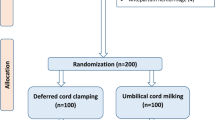Abstract
OBJECTIVE:
To investigate the clinical effects of early versus late cord clamping in preterm infants.
STUDY DESIGN:
A total of 32 premature infants were prospectively randomized. The following parameters were measured: Initial spun hematocrit (Hct), hemoglobin (Hgb), red blood cell (RBC) counts, frequency of blood transfusions, peak serum bilirubin, mean blood pressure (MBP), oxygen index, intraventricular hemorrhage, and significant patent ductus arteriosus (PDA).
RESULTS:
Over the 4-week study period, the delayed cord clamping (DCC) group exhibited a decrease in the frequency of blood transfusion (p < 0.001) and also a decrease in albumin transfusions over the first 24 hours (p < 0.03). MBP in the first 4 hours was higher in the DCC group (p < 0.01), and there were statistically significant increases in Hct (21%), Hgb (23%), and RBC count (21%) compared with the early cord clamping group. The risks of patent ductus arteriosus, hyperbilirubinemia, or intraventricular hemorrhage were similar in both groups. Late clamping of the umbilical cord had little or no effect on the oxygen index.
CONCLUSION: DCC significantly reduced the requirement for blood and albumin transfusion. It also increased the initial Hct, RBC count, Hgb levels, and MBP.
Similar content being viewed by others
Author information
Authors and Affiliations
Rights and permissions
About this article
Cite this article
Ibrahim, H., Krouskop, R., Lewis, D. et al. Placental Transfusion: Umbilical Cord Clamping and Preterm Infants. J Perinatol 20, 351–354 (2000). https://doi.org/10.1038/sj.jp.7200408
Published:
Issue Date:
DOI: https://doi.org/10.1038/sj.jp.7200408
- Springer Nature America, Inc.
This article is cited by
-
Patterns of phlebotomy blood loss and transfusions in extremely low birth weight infants
Journal of Perinatology (2019)
-
Effect of delayed cord clamping on hematocrit, and thermal and hemodynamic stability in preterm neonates: A randomized controlled trial
Indian Pediatrics (2017)
-
Comparison of three types of intervention to enhance placental redistribution in term newborns: randomized control trial
Journal of Perinatology (2015)
-
Effect of Early versus Delayed Cord Clamping on Hematological Status of Preterm Infants at 6 wk of Age
The Indian Journal of Pediatrics (2015)
-
Umbilical cord blood acid–base and gas analysis after early versus delayed cord clamping in neonates at term
Archives of Gynecology and Obstetrics (2011)




